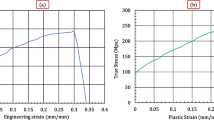Abstract
Conventional sheet metal spinning is an incremental forming process which typically involves the cost-effective and high-quality manufacturing of axissymmetric parts. The process is usually executed by highly skilled and experienced personnel which is able of optimizing the process parameters during production. Numerical simulation of the process can substantially help discovering systematic methodologies for optimal parameter determination and thus enable the full automation of the process using CNC machines. The present work aims to assess the quality of numerical modelling techniques by a direct comparison with metal spinning experiments. Based on the geometry and thickness distribution of intermediate and final stages of a spinned component, which are measured using the Optical 3D Digitization technique, the quality and validity of different numerical modeling approaches are assessed. Subsequently, deformation mechanisms occurring during process are identified, analysed and discussed.












Similar content being viewed by others
References
Runge M (1994) Spinning and flow forming. Leifeld GmbH
Emmens WC, Van den Boogaard AH (2009) An overview of stabilizing deformation mechanisms in incremental sheet forming. J Mater Process Technol 209(8):3688–3695
Music O, Allwood JM, Kawai K (2010) A review of the mechanics of metal spinning. J Mater Process Technol 210(1):3– 23
Li J, Geng P, Shen J (2013) Numerical simulation and experimental investigation of multistage incremental sheet forming. Int J Adv Manuf Technol 68(9-12):2637–2644
Quigley E, Monaghan J (2002) Enhanced finite element models of metal spinning. J Mater Process Technol 121(1):43–49
Liu JH, Yang H, Li YQ (2002) A study of the stress and strain distributions of first-pass conventional spinning under different roller-traces. J Mater Process Technol 129(1):326–329
Kleiner M, Göbel R, Kantz H, Klimmek C, Homberg W (2002) Combined methods for the prediction of dynamic instabilities in sheet metal spinning. CIRP Ann Manuf Technol 51(1):209– 214
Kleiner M, Göbel R, Klimmek C, Heller B, Reitmann V, Kantz H (2004) Wrinkling in sheet metal spinning. Nonlinear Dynamics of Production Systems:287–303
Sebastiani G, Brosius A, Ewers R, Kleiner M, Klimmek C (2006) Numerical investigation on dynamic effects during sheet metal spinning by explicit finite-element-analysis. J Mater Process Technol 177(1):401–403
Sebastiani G, Brosius A, Homberg W, Kleiner M (2007) Process characterization of sheet metal spinning by means of finite elements. Key Eng Mater 344:637–644
Hamilton S, Long H (2008) Analysis of conventional spinning process of a cylindrical part using finite element method. Steel Res Int 79(1):632–639
Essa K, Hartley P (2009) Numerical simulation of single and dual pass conventional spinning processes. Int J Mater Form 2(4):271–281
Essa K, Hartley P (2010) Optimization of conventional spinning process parameters by means of numerical simulation and statistical analysis. Proc Inst Mech Eng B J Eng Manuf 224(11):1691–1705
Beni HR, Beni YT, Biglari FR (2011) An experimental-numerical investigation of a metal spinning process. Proc Inst Mech Eng C J Mech Eng Sci 225(3):509–519
Wang L, Long H (2011) Investigation of material deformation in multi-pass conventional metal spinning. Mater Des 32(5):2891–2899
Wang L, Long H (2011) A study of effects of roller path profiles on tool forces and part wall thickness variation in conventional metal spinning. J Mater Process Technol 211(12):2140– 2151
Wang L, Long H (2011) Investigation of effects of roller path profiles on wrinkling in conventional spinning. In: Proceedings of 10th international conference on technology of plasticity, Aachen, Germany
Wang L, Long H, Ashley D, Roberts M, White P (2011) Effects of the roller feed ratio on wrinkling failure in conventional spinning of a cylindrical cup. Proc Inst Mech Eng B J Eng Manuf:0954405410396024
Watson M, Long H (2014) Wrinkling failure mechanics in metal spinning. Procedia Engineering 81:2391–2396
Watson M, Long H, Lu B (2014) Investigation of wrinkling failure mechanics in metal spinning by box-behnken design of experiments using finite element method. Int J Adv Manuf Technol:1– 15
Wang L, Long H (2013) Roller path design by tool compensation in multi-pass conventional spinning. Mater Des 46:645–653
Shi F, Long H, Zhan M, Ou H (2014) Uncertainty analysis on process responses of conventional spinning using finite element method. Struct Multidiscip Optim 49(5):839–850
Ahmed KI, Gadala MS, El-Sebaie MG (2015) Deep spinning of sheet metals. Int J Mach Tools Manuf 97:72–85
Barlat F, Brem JC, Yoon JW, Chung K, Dick RE, Lege DJ, Pourboghrat F, Choi S-H, Chu E (2003) Plane stress yield function for aluminum alloy sheets-part 1: theory. Int J Plast 19(9):1297– 1319
Wang L, Long H, Ashley D, Roberts M, White P (2010) Analysis of single-pass conventional spinning by taguchi and finite element methods. Steel Res Int 81(9):974–977
Olovsson L, Simonsson K, Unosson M (2005) Selective mass scaling for explicit finite element analyses. Int J Numer Methods Eng 63(10):1436–1445
Author information
Authors and Affiliations
Corresponding author
Ethics declarations
The present work has been carried out in the scope of the Project Nr. 17231.1 PFIW-IW funded by the Swiss Federal Commision for Technology and Innovation (CTI). The authors declare that they have no conflict of interest.
Rights and permissions
About this article
Cite this article
Rentsch, B., Manopulo, N. & Hora, P. Numerical modelling, validation and analysis of multi-pass sheet metal spinning processes. Int J Mater Form 10, 641–651 (2017). https://doi.org/10.1007/s12289-016-1308-5
Received:
Accepted:
Published:
Issue Date:
DOI: https://doi.org/10.1007/s12289-016-1308-5




